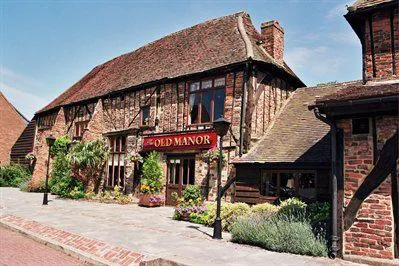The name Potters Bar is thought to derive from evidence of a Roman pottery, believed to have operated in the Parkfield recreation ground area.
The Potters Bar of today owes its growth and development to the coming of the railways.
However, for several hundred years a linear settlement has existed here on the edge of Enfield Chase in the Parish of South Mimms. From medieval beginnings in the grounds of the present Morven Park House, it spread out along what became the High Street in subsequent centuries.
The railway station opened in August 1850 on what was then the London to Peterborough line passing between the villages of Potters Bar and South Mimms. This attracted people to live in the area and led to the building of a number of houses at the beginning of the century at the northern end of Darkes Lane.
The pressure of suburban development was at its height in the 1930s when the population of Potters Bar trebled. Light industry arrived after the Second World War and two large council estates were built in the 1950s. As a result of rapid suburban growth the town has two shopping areas at Darkes Lane and the High Street.

Continuing development of road and rail links, notably the M25, has enabled Potters Bar to grow into a modern town with an active community life.
The Potters Bar Museum was provided by the council and is run voluntarily by members of the Potters Bar and District Historical Society at the Wyllyotts Centre in Darkes Lane.
Potters Bar is set in the midst of countryside, as is nearby rural South Mimms. It is probably the most ancient part of this area, mentioned in the Domesday Survey of 1086 as 'one berewick which is called Mimes'.
A Norman motte and bailey castle dating from the reign of King Stephen once occupied a site north-west of Mimms Hall. The castle is thought to have been built by the famous traveller and writer Geoffrey de Mandeville in 1141. Excavations here have disclosed the foundations of buildings including a timber keep or tower, and quantities of pottery, inscribed tiles and metalwork from the site are now in the possession of English Heritage.
St Giles Church at South Mimms was built in stages between C.1140 and 1525 and was restored by G.E. Street in 1876-77.
St Giles contains many fine monuments, notably those of the Frowyk family, Lords of the Manor of Old Ford and leading City of London goldsmiths. The churchyard contains a Doric style mausoleum C.1907 of the Cavendish-Bentinck family.
In the Middle Ages the parish stretched to the edge of Enfield Chase and covered all of Potters Bar, almost as far as Wood Street, Barnet. The parish registers go back to 1558 and the church is fortunate that its well-documented history provides a miniature social record of the nation.
Potters Bar’s Twin Towns – Franconville and Viernheim
The twinning clubs in Franconville (near Paris) and Viernheim (near Mannheim) offer Potters Bar residents a very warm welcome and a host of interesting things to see and do. Schools, special interest clubs, families and individuals can be sure of a memorable weekend – or longer stay – if they accept the invitation. Clearly it would be appreciated if the invitation is reciprocated.
One or two weekend exchanges in a year is usual. English is the common language, although attempts at French or German is appreciated.
So for continental cuisine, sightseeing, entertainment, making new friends and enjoying new experiences, why not give it a go?
To find out more, contact the Potters Bar Twin Town Network – pbtwintowns@hotmail.com.